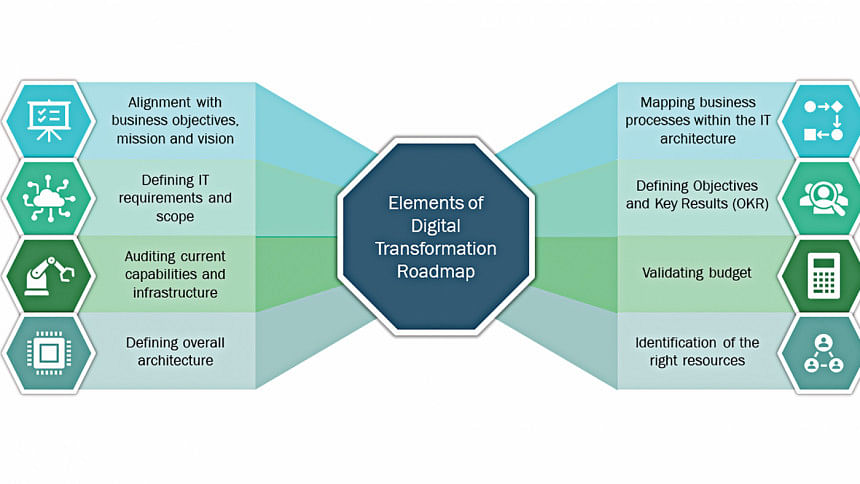Survive and thrive in the post-pandemic period digital transformation

The ongoing pandemic has brought us one of the biggest crises we have ever faced in terms of health and safety, employment and the overall economy.
This is an unprecedented situation and to win this battle, our leaders in both public and private sectors need to think differently, go beyond the traditional means, and bring about digital transformation in both public and private organisations to survive and thrive in the aftermath of coronavirus.
But what is digital transformation? Digital transformation is about applying technologies to drastically change traditional processes, products and services into data-driven, highly connected solutions that can be monetised through extreme efficiency gains and new business models.
The pandemic has shown us that a business cannot wait for the transformation it knows it needs.
In a recent survey conducted by Forbes among the Fortune 500 companies, 75 per cent of their chief executive officers mentioned that this crisis will accelerate the pace of technological transformation in their companies and across industries.
We are already seeing a growing number of organisations investing in technologies -- from business intelligence and demand forecast to marketing, customer support, supply chain and back office transformation.
However, there is a caveat to optimise the return on investment of IT spending by the companies. Many IT departments work reactively.
They are executing ad hoc projects with short-term goals rather than proactively steering the strategic use of technologies within the company.
Now that enterprises are dealing with more IT initiatives than ever, such a reactive approach is at best ineffective and at worst detrimental to growth.
Instead, there should be a comprehensive digital transformation strategy to guide different projects, providing a holistic and long-term vision to the organisation's technological needs.
The transformation theme for the next era will be focused on six key areas of business: (i) understanding customers -- how we design and sell products; (ii) supply chain automation -- how supply chain networks become part of the digital ecosystem; (iii) operational efficiency -- how we improve operations and leverage new technology options; (iv) modern workforce -- how we re-energise and manage our people remotely; (v) accelerating digital investments -- how we prioritise and implement digital initiatives; and (vi) business model evolution -- how to leverage digitally modified business.
We have seen that as soon as physical distancing and home quarantine were enforced around the globe, companies that were already utilising digital means of running operations or quickly adopted solutions like remote work tools stayed productive amid this pandemic.
On the other hand, companies without technological adoption struggled the most.
We are lucky to be living in the "Industry 4.0" era.
With the integration of tools, re-engineered processes, and emerging technologies such as internet of things, machine learning, artificial intelligence, cloud technologies etc., most of the businesses across industries can automate as much as 90 per cent of their workflows.
Short-sighted executives will still look for ways to cut down IT costs believing that it will help them survive.
However, it is the traditional way of thinking, and our traditional way of running a business has already failed us.
The giant mammoths could not survive the ice age with all their might by not adapting to climate change, but those who evolved did.
The evolution for our enterprises in the upcoming days translates to digital transformation and the visionary long-sighted leaders like the CEOs of Fortune 500 companies have already understood the importance of allocating their limited resources to invest in IT solutions and automation.
The very first step towards achieving that evolution is to prepare a digital transformation roadmap for the organisation.
So, what is a digital transformation roadmap?
A digital transformation roadmap is a long-term, detailed set of documents that encompass the company's vision and strategic planning for technological transformation.
It will provide a unifying approach to implement tools and technologies across the company which will increase efficiency, reduce duplication of work, enhance collaboration, and in turn, will minimise errors and operational costs to a great extent.
Moreover, it will ensure that the business remains operational during the pandemic and prolonged lockdowns.
A well-designed digital transformation strategy should have some essential elements such as alignment with business objectives, mission and vision; defining IT requirements and scope; auditing current capabilities and infrastructure; defining overall architecture; mapping business processes within the IT architecture; defining objectives and key results; validating budget and identification of the right resources.
Our company eGeneration with our world-class productivity solutions and deep expertise in emerging technologies is proud to help many leading global and local organisations formulate their digital transformation strategies to thrive in the next era.
To ensure success in that digital-first world, we have to create a shared transformative vision of digital future, engage employees at scale to make the vision a reality, establish strong digital governance to steer the course, and fuse IT and business to build digital skills and transform technology platforms.
When the Industry 4.0 revolution started, it allowed us to embrace technologies in our workflows.
Some of us took that opportunity but many of us waited.
This pandemic has come with a new reality that will not allow us to wait any longer.
Companies that will embrace the new normal with digital transformation will choose the road to prosperity post-pandemic and beyond.
However, the companies that will not integrate technology in their business functions, who are still hostile to technology, are going to have a very hard time doing business in near future because the technological transformation across the industries will be massive and mind-boggling.
Now is the time to think bravely, plan boldly and act wisely.
The writer is chairman of eGeneration Group, general partner of Pegasus Tech Ventures, president of VCPEAB and former president of BASIS

 For all latest news, follow The Daily Star's Google News channel.
For all latest news, follow The Daily Star's Google News channel. 



Comments